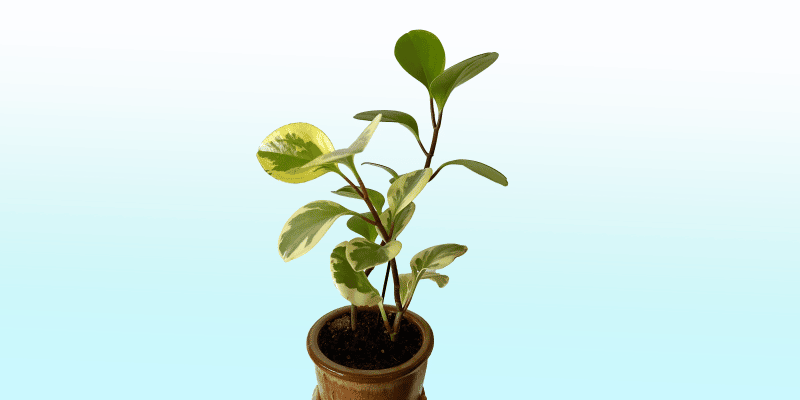Peperomia obtusifolia just looks like a classic houseplant. Also known as the “Baby rubber plant,” it features bright, dark green leaves with a delightfully thick leathery texture.
I mean, seriously, you have to feel these leaves.
We’ll cover how to take care of Peperomia obtusifolia, the many different ways it can be propagated, and how to get a beautifully bushy, dense look.
Table of Contents
Peperomia Obtusifolia Care Guide
History, habitat, and characteristics
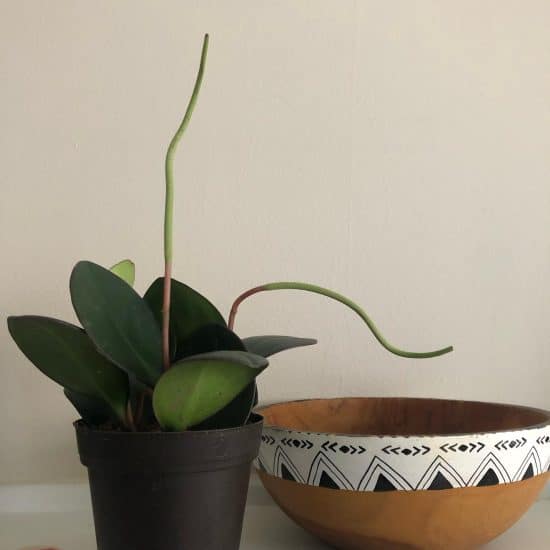
Peperomia obtusifolia, affectionately known as blunt-leaved peperomia or baby rubber plant, is a tropical perennial shrub of the Piperaceae family. Native to South America and the Caribbean, it has also been found in southern Florida.
Peperomia obtusifolia has a succulent-like quality, thanks to its leathery foliage and glossy coat. It also boasts a variety of cultivars that feature really pretty yellow-gold variegated leaves.
My personal favorite? Peperomia obtusifolia ‘Minima,’ with its diminutive green leaves.
These leaves are safe to touch, and you should! They’re firm, juicy, and leathery, and feature a glossy coat that helps keep pests away. Go on, give it a little squeeze!
Called the baby rubber plant because of how much it resembles the Ficus elastica, the Peperomia obtusifolia is actually unrelated and does have different care.
Also sometimes known as the “Pepper Face Plant,” they’re easy to care for and tend to prefer being underwatered. You can even prune back and replant in the same pot to encourage a bushier appearance.
If you inspect the thick, dark stems closely, you’ll notice each node features tiny sprouts of aerial roots: this is because the Baby rubber plant is an epiphyte and naturally reaches out to other plants in its natural rainforest habitat to grow taller.
You can let them take hold of a pole or cut them back as needed.
Light
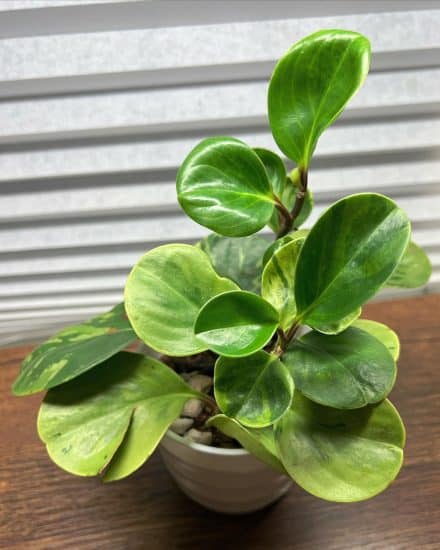
The Baby rubber plant’s appearance varies heavily depending on how much light they get. With more light, you’ll notice a shorter distance between the stem nodes, with fuller growth. If you prefer a spindly look, just move your plant back a bit and you’ll see it reach out to touch that sunlight.
Variegated Peperomia obtusifolia, like most house plants, grows half as fast as the pure-green versions due to less chlorophyll in the leaves.
If Peperomia obtusifolia isn’t getting enough light, the leaves may start to droop and the stems will look weaker than usual. If there’s too much light, the leaves may start to yellow or burn and there may be pale, faded colors in the foliage.
If you have a variegated cultivar (like Peperomia obtusifolia ‘variegata’) it is especially important to provide bright, indirect light or you’ll soon have leaves that are completely green. If this happens, don’t worry about your variegated baby rubber plant. We’ll add some more light and bring out that variegation in no time.
Direct sunlight can cause damage to the foliage, leading to yellow or faded leaves and crispy, brown spots along the edges. Small amounts of incidental direct sun are survivable, but routine exposure will make life difficult for your baby rubber plant.
Water
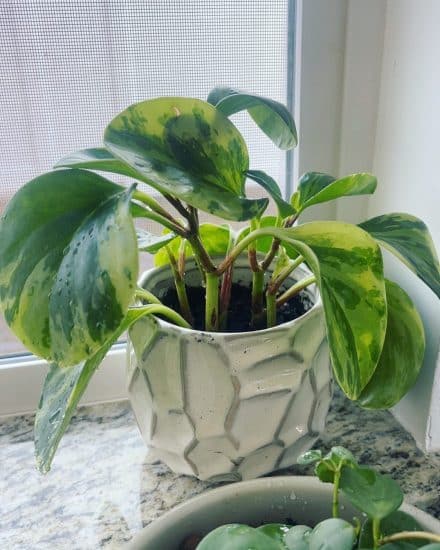
Peperomia obtusifolia easily tolerates a bit of neglect if underwatered, but doesn’t forgive overwatering quite as well.
We often advise testing the soil with a finger before watering, but for your Baby rubber plant, we have another trick up our sleeve.
Before watering Peperomia obtusifolia, squeeze the leaves. If they feel soft and limp, time to water. (Unless you’ve already just watered, in which case, this could be a sign of overwatering!). If they’re firm, leave the plant alone. Their leaves store water and don’t require the excessive watering some other houseplants prefer.
- Too much water: could result in the plant developing yellow leaves and soft, droopy stems. Both are a sign of rot in the soil. We’ll cover how to deal with this later on in the last section of the article.
- Not enough water: when plants are not receiving enough water, the leaves may become dry, brittle, and curl or droop. Check the soil for dryness, and if it’s dry or you notice it pulling away from the sides of the pot, you likely need to water more frequently.
Temperature and humidity
Unlike a lot of other houseplants, Peperomia obtusifolia can actually tolerate a wide range of temperatures (but it’s a bit more particular about humidity).
Think of your Peperomia obtusifolia just like a houseguest – if you keep the same temperature and humidity conditions you would want for yourself, it’ll be comfy and want to stay around for a while. A few small drafts? No big deal for this plant.
Temperature: Peperomia obtusifolia thrives between 65-80 degrees F. Young propagations actually do a bit better in the cold, so feel free to move those to a chillier part of the house. The colder soil (if given enough light) inhibits fungal growth, which means you can keep it a bit wetter as its small root systems are still forming.
Humidity: Humidity levels between 40-70% are fantastic. If you’re having trouble keeping them up, a humidifier, pebble tray, or even clustering plants together can all help.
Soil and planting
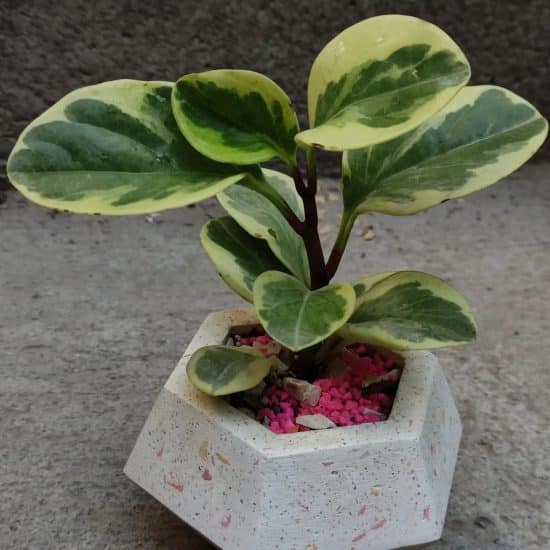
Baby rubber plants love being a bit rootbound. They tend to have small, fine root structures that need time to explore their soil. This has implications for propagation that we’ll cover later on, too.
You can optionally fertilize lightly, as you would most other indoor plants. Make sure to use a balanced liquid fertilizer that’s diluted only during the spring/summer, and water a little bit just before and after to avoid any leaf burn.
Potting soil-wise, you’ll want a well-aerated soil similar to this mix:
- Potting soil (not garden soil, tyvm)
- Orchid bark (great for epiphytes)
- Coco coir (degrades slowly and resists compaction)
- Perlite (adds water retention, aeration)
If you have worm castings, toss ’em in!
Propagation guide
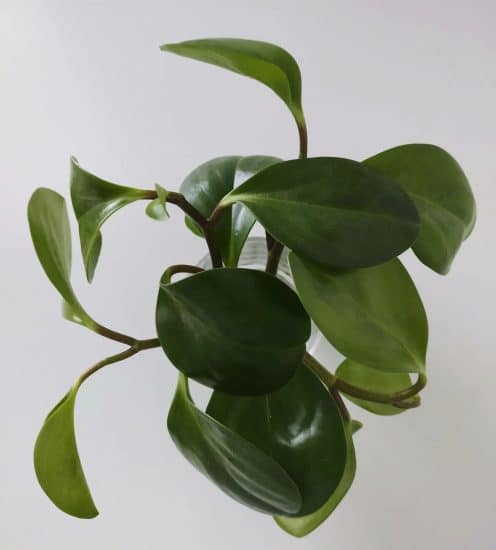
Baby rubber plants can be propagated by leaf cuttings or stem tip cuttings very easily. We’ll cover both approaches (leaf cutting is so easy).
Peperomia obtusifolia propagates faster from its main stem, and if you only have a single leaf on your cutting, it may take you another 8-9 months to see growth up to 5 leaves.
Stem cutting propagation method
Propagating a baby rubber plant via stem cuttings is super easy, even compared with other indoor plants. They grow fast if kept moist, so we’ll propagate them right into the soil.
You can either plant them back into the same Peperomia obtusifolia soil that the mother plant came from, or into a new pot. It’s up to you.
- Remove any dead or diseased Peperomia obtusifolia leaves before starting the propagation process.
- With a sterilized pair of scissors, take a stem cutting with at least one healthy leaf. Multiple leaves are preferred for faster growth.
- Place the cutting directly into soil. You’ll want to keep the soil around the cutting moist, so often a separate container with its own soil is helpful so you don’t oversaturate the parent.
- In 2-3 weeks, you should notice (if you move soil gently) substantial fine root growth, and now you can water more infrequently.
That’s it! They’re super easy to grow indoors, and you can avoid rooting hormone completely.
Leaf cutting approach: so simple. Cut a leaf in half and plant it right into moist potting mix, even back into the same pot. You’ll soon see veins sprouting right out into the moist soil and turning into roots. Don’t let this section dry out too much —water it every few days.
These are super simple plants to propagate. Experiment with your Baby rubber plants and try both approaches. Replant into the same pot for a bushier appearance or into separate pots to hand out to your friends.
Common issues
Baby rubber plant care isn’t a fool-proof science, but more of a series of measured guesses. When you first get your plant, take notice of how it begins its journey.
You can even take a picture — this way, you’ll notice any differences as they emerge.
Yellowing leaves
A Baby rubber plant can show yellow leaves if pretty badly neglected, so this is an important symptom to look out for before things get much worse. If they’re yellowing, browning, and feel dry, this is a sign of underwatering or too much direct light.
If you notice they’re saggy, squishy, or even moldy, this means too much water and potentially root rot (which we’ll cover in a bit).
Either way, adjust its light/water intake and make sure the soil is draining between watering.
Leaning/Toppling Over
If your Peperomia obtusifolia is leaning or toppling over as it grows taller, you may need to provide it with support. If you notice weak growth, move your plant to a brighter location and stake it if desired.
Diseases and pests
Peperomia obtusifolia, like other houseplants, can have issues with diseases and pests if it finds itself in a weakened state. So, your first step is hopefully to prevent any of these bugs or issues from showing up to begin with. Usually, there will be signs (yellowing leaves, wet soil) that you notice well before.
However, if you find yourself with bugs or rot, this can be remedied in almost all cases, especially since the Baby rubber plant holds true to its name: these leaves are durable!
Spider Mites
Spider mites are a common pest for Peperomia obtusifolia plants. These small bugs feed on a plants’ tissue and can easily be spotted by examining the undersides of leaves for black or white spots. You’ll notice webbing on the undersides of leaves as they try to nibble away.
The fix is almost always neem oil spray and physically removing them with a blast of cold water, just like with mealybugs.
Root Rot:
This is almost always caused by extreme overwatering and soil that doesn’t dry out. Symptoms include yellowing leaves, rotting stems, and mushy, brown or black rotten roots. The fix for this can be tricky. You’ll want to dig up your plant and cut off any affected roots before repotting in fresh soil.
Ensure the soil mixture drains easily, and reduce watering significantly to avoid a recurrence. If left alone, rotting roots will easily destroy a plant.
Conclusion
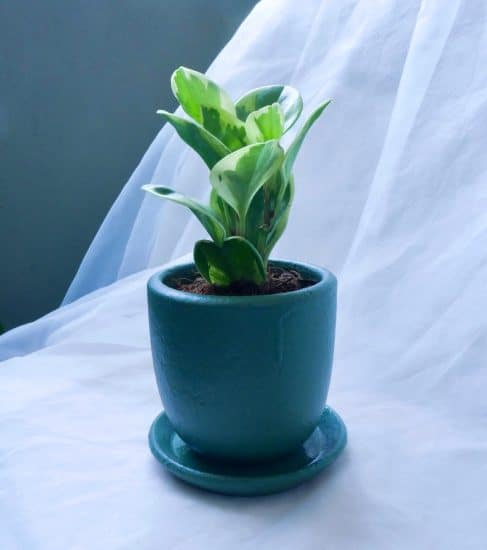
Peperomia obtusifolia (Baby rubber plant) is a fast-growing epiphyte from South America with delightfully leathery leaves. Baby rubber plant grows best in warm temperatures, but can tolerate a bit of a chill, especially with new growth after propagation (just make sure to include at least a few leaves to give your young plants a better chance of surviving).
Diluted liquid fertilizer is fine to use in the growing season, and if you want bushier growth, you can prune and even replant in the same small pot.
Baby rubber plant care tips:
- Avoid direct sun while providing lots of bright light to encourage new growth. Avoid extended periods of low light.
- Offer your Baby rubber plant a humid environment free of cold drafts. A pebble tray filled with water and small stones can help elevate your local humidity.
- Peperomia plants prefer to be slightly root bound, so pick a smaller pot size than you might otherwise.
- Give the leaves a gentle squeeze. If they feel firm, you can wait to water them.
If you have any questions regarding baby rubber plant care, need tips, or have some cute varieties that you want to show off, send us an email!
FAQ
Why is it called the baby rubber plant?
Just one look at this plant and you’ll notice a strikingly similar appearance (leaf color, shape) to the Rubber Tree. It’s also known as the “Pepper Face Plant” or “American Rubber Plant.”
The botanical name is Peperomia obtusifolia. Obtusifolia means “blunt-leaved” and Peperomia means “pepper-like.” Thanks, ancient Greece!
How do leaf cuttings work with baby rubber plants?
Oh, these are so much fun and a great alternative to stem tip cuttings. You really just pop a leaf off of your Baby rubber plant, cut it in half, and plant the upper half in soil to propagate a completely new clone of the mother plant.
Does Peperomia obtusifolia suffer from any issues that other house plants don’t?
It is pretty water sensitive. With its succulent-like leaves, this Peperomia really prefers to have the soil dry out routinely. This plant is also happy while root bound and does well with a small pot size, where its extensive root system can explore the soil with its fine hairs,.
If soil moisture is allowed to persist, you’re increasing the likelihood of fungal diseases and other really tricky issues.

